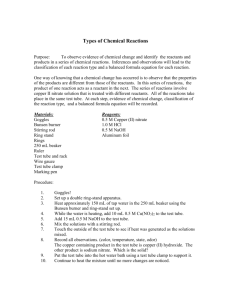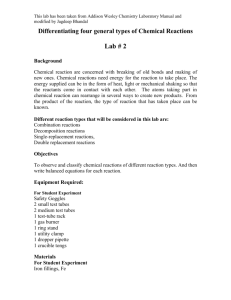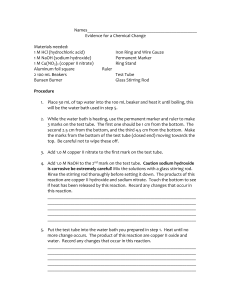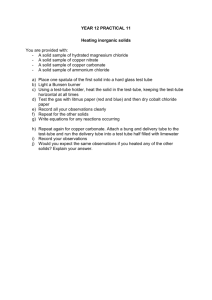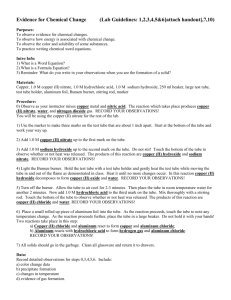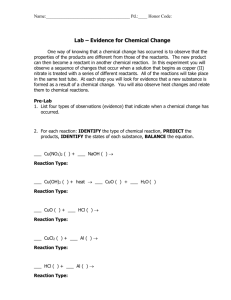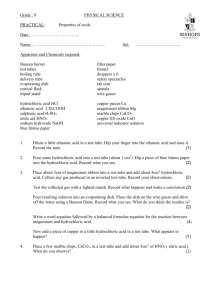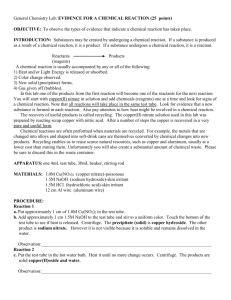LAB: Evidence for Chemical Change
advertisement
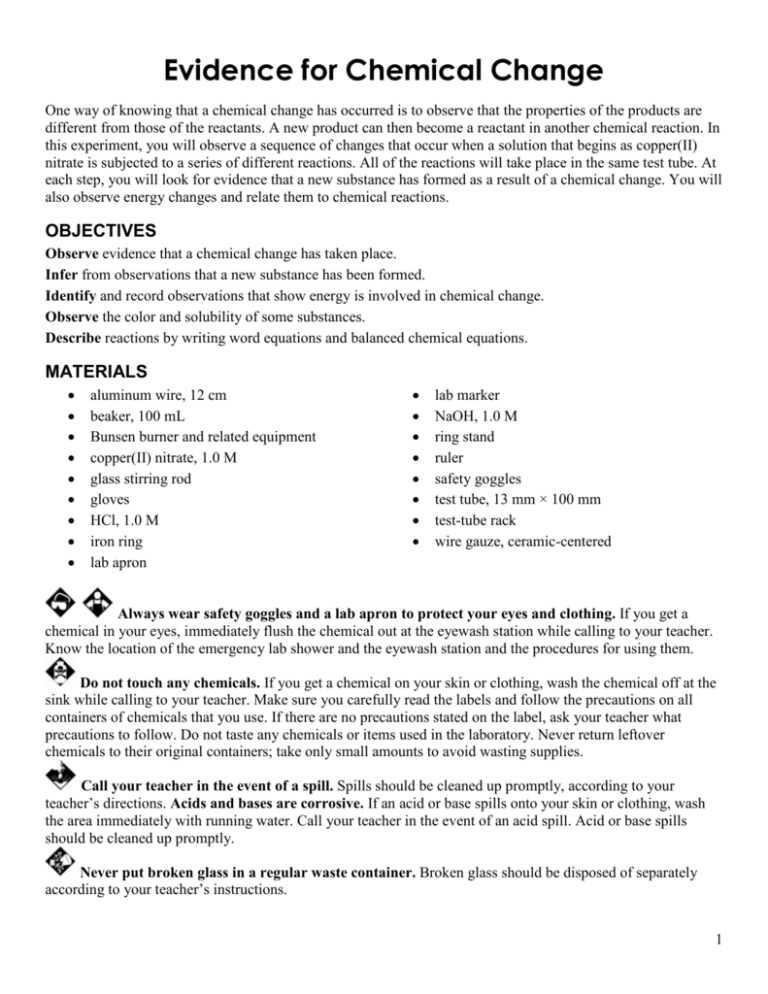
Evidence for Chemical Change One way of knowing that a chemical change has occurred is to observe that the properties of the products are different from those of the reactants. A new product can then become a reactant in another chemical reaction. In this experiment, you will observe a sequence of changes that occur when a solution that begins as copper(II) nitrate is subjected to a series of different reactions. All of the reactions will take place in the same test tube. At each step, you will look for evidence that a new substance has formed as a result of a chemical change. You will also observe energy changes and relate them to chemical reactions. OBJECTIVES Observe evidence that a chemical change has taken place. Infer from observations that a new substance has been formed. Identify and record observations that show energy is involved in chemical change. Observe the color and solubility of some substances. Describe reactions by writing word equations and balanced chemical equations. MATERIALS • • • • • • • • • aluminum wire, 12 cm beaker, 100 mL Bunsen burner and related equipment copper(II) nitrate, 1.0 M glass stirring rod gloves HCl, 1.0 M iron ring lab apron • • • • • • • • lab marker NaOH, 1.0 M ring stand ruler safety goggles test tube, 13 mm × 100 mm test-tube rack wire gauze, ceramic-centered Always wear safety goggles and a lab apron to protect your eyes and clothing. If you get a chemical in your eyes, immediately flush the chemical out at the eyewash station while calling to your teacher. Know the location of the emergency lab shower and the eyewash station and the procedures for using them. Do not touch any chemicals. If you get a chemical on your skin or clothing, wash the chemical off at the sink while calling to your teacher. Make sure you carefully read the labels and follow the precautions on all containers of chemicals that you use. If there are no precautions stated on the label, ask your teacher what precautions to follow. Do not taste any chemicals or items used in the laboratory. Never return leftover chemicals to their original containers; take only small amounts to avoid wasting supplies. Call your teacher in the event of a spill. Spills should be cleaned up promptly, according to your teacher’s directions. Acids and bases are corrosive. If an acid or base spills onto your skin or clothing, wash the area immediately with running water. Call your teacher in the event of an acid spill. Acid or base spills should be cleaned up promptly. Never put broken glass in a regular waste container. Broken glass should be disposed of separately according to your teacher’s instructions. 1 Do not heat glassware that is broken, chipped, or cracked. Use tongs or a hot mitt to handle heated glassware and other equipment because hot glassware does not always look hot. When using a Bunsen burner, confine long hair and loose clothing. If your clothing catches on fire, WALK to the emergency lab shower and use it to put out the fire. When heating a substance in a test tube, the mouth of the test tube should point away from where you and others are standing. Watch the test tube at all times to prevent the contents from boiling over. Procedure 1. Put on safety goggles, gloves, and a lab apron. 2. Place 50 mL of water into the 100 mL beaker and heat it until boiling. This will be the water bath you will use in Step 6. 3. While the water bath is heating, use the lab marker and ruler to make three marks on the test tube that are 1 cm apart. Make the marks starting at the bottom of the test tube and moving toward the top. 4. Add 1.0 M copper(II) nitrate to the first mark on the test tube, as shown in Figure 1. 5. Add 1.0 M sodium hydroxide (NaOH) up to the second mark on the test tube, as shown in Figure 2. Record your observations of the changes that occurred in the Data Table in the observations section of your lab report. If you need more room, additional observations can be recorded underneath the Data Table CAUTION: Sodium hydroxide is corrosive. Be certain to wear safety goggles, gloves, and a lab apron. Avoid contact with skin and eyes. If any of this solution should spill on you, immediately flush the area with water and notify your teacher. Figure 1 Figure 2 Figure 3 Observations: 6. Put the test tube into the water bath you prepared in Step 2. Heat it until no more changes occur. The products of this reaction are copper (II) oxide and water. Record the changes that occur in the test tube. Observations: 2 7. Remove the test tube from the hot-water bath. Turn off the burner. Cool the test tube and its contents for 2 min in room-temperature water. Add the 1.0 M hydrochloric acid (HCl) to the third mark, as shown in Figure 3. CAUTION: Hydrochloric acid is corrosive. Be certain to wear safety goggles, gloves, and a lab apron. Avoid contact with skin and eyes. Avoid breathing vapors. If any of this solution should spill on you, immediately flush the area with water and then notify your teacher. Mix with the stirring rod. Rinse the stirring rod. The new products are copper (II) chloride and water. Record the changes that occur in the test tube. Observations: 8. Place a 12-cm piece of aluminum wire in the test tube. Leave it until no reaction is observed. Touch the bottom of the test tube to check for temperature change. Two reactions take place. Copper(II) chloride and aluminum produce copper and aluminium chloride. The aluminum also reacts with the hydrochloric acid to form hydrogen and aluminum chloride. Record the changes that occur in the test tube. Observations: 9. Remove the wire from the test tube. Compare the copper formed to a sample of copper wire. Record your observations. Observations: 10. Clean all apparatus and your lab station. Return equipment to its proper place. Dispose of chemicals and solutions in the containers designated by your teacher. Do not pour any chemicals down the drain or put them in the trash unless your teacher directs you to do so. Wash your hands thoroughly after all work is finished and before you leave the lab. 3 Data Table Reactants (names) Products (names) Observations of Products Precipitate (solid) Supernate (liquid) + + + + + + 4 QUESTIONS: Analysis 1. In this experiment, what were some causes of chemical changes? 2. In what two ways is energy involved in chemical change? Cite some specific instances from this experiment. 3. In the last step of the experiment, where is the aluminum chloride? How could you recover it? 4. What is the color of solutions of copper compounds? 5. Refer to the procedure steps in the experiment, and complete the following word equations. Write balanced chemical equations for each. a. copper(II) nitrate + sodium hydroxide → b. copper(II) hydroxide + energy → c. copper(II) oxide + hydrochloric acid → d. copper(II) chloride + aluminum → e. hydrochloric acid + aluminum → QUESTIONS: Forming Conclusions 6. List four types of observations that indicate when a chemical change has occurred. 7. The chemical conversion of one product into another useful product is the basis for recycling. Explain how the type of reactions you observed in this experiment could be useful in the recycling of copper. 8. Describe the advantages and disadvantages of recycling metals as was done in this experiment. 5
